Impacts of increasing compound hot-dry events on vegetation under the warming-wetting trend in Northwest China
IF 8
1区 环境科学与生态学
Q1 GEOGRAPHY, PHYSICAL
引用次数: 0
Abstract
In a warming world, climate extremes tend to be more frequent and intense. The exceptional response of ecosystems triggered by extreme climate events under a warmer and wetter climate in northwest China (NWC) has aroused growing concern. However, understanding the responses of vegetation to climate extremes from the compound events perspective remains challenging. In this study, we identify the climate dynamics in NWC during 1971–2020 based on daily meteorological observations, focusing on the changes in compound hot-dry events (CHDEs) during the warmer and wetter period. We further explore the effects of CHDEs on vegetation by examining vegetation anomalies and recovery time using daily gross primary productivity (GPP) data. The results show a clear warmer and wetter period in NWC during 2000–2020. No signs of a hiatus in CHDEs increase are observed during this period, and even the duration of CHDEs in western NWC keeps showing an increasing tendency. Vegetation in eastern NWC, with a lower probability of GPP anomalies, exhibits stronger resistance of ecosystems to CHDEs than in western NWC. In NWC, vegetation typically returns to its normal state in 5.50 days on average, but exhibits greater resilience in the western region, where it takes less recovery time (4.82 days). Vegetation in the central region shows the lowest probability of GPP anomalies and relatively longer recovery time, likely due to its higher altitudes. Our research underscores the imperative to address the considerable impacts of CHDEs on vegetation growth even as the regional climate becomes increasingly warmer and wetter.
求助全文
约1分钟内获得全文
求助全文
来源期刊

Geography and Sustainability
Social Sciences-Geography, Planning and Development
CiteScore
16.70
自引率
3.10%
发文量
32
审稿时长
41 days
期刊介绍:
Geography and Sustainability serves as a central hub for interdisciplinary research and education aimed at promoting sustainable development from an integrated geography perspective. By bridging natural and human sciences, the journal fosters broader analysis and innovative thinking on global and regional sustainability issues.
Geography and Sustainability welcomes original, high-quality research articles, review articles, short communications, technical comments, perspective articles and editorials on the following themes:
Geographical Processes: Interactions with and between water, soil, atmosphere and the biosphere and their spatio-temporal variations;
Human-Environmental Systems: Interactions between humans and the environment, resilience of socio-ecological systems and vulnerability;
Ecosystem Services and Human Wellbeing: Ecosystem structure, processes, services and their linkages with human wellbeing;
Sustainable Development: Theory, practice and critical challenges in sustainable development.
 求助内容:
求助内容: 应助结果提醒方式:
应助结果提醒方式:


